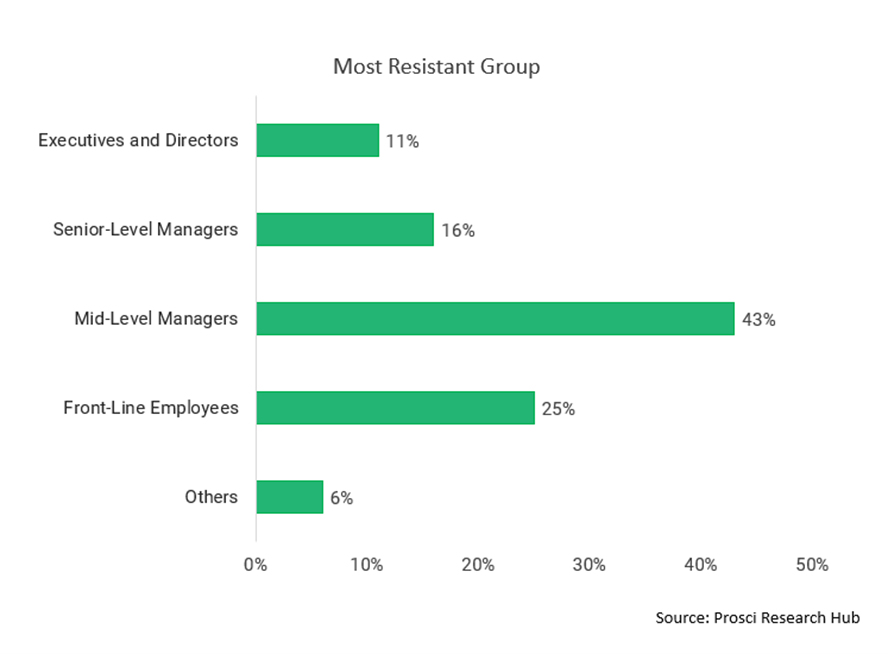
Imagine you're flipping a coin to predict your business success. With poor change management, it's like hitting heads just 15% of the time. But with excellent organizational change management, you turn into a lucky charm, landing tails (success) a whopping 93% of the time! In other words, good organizational change management practices make your business six times more likely to thrive. Think of it as the magic ingredient your business needs to reach its full potential.
In the dynamic world of business, standing still is not an option. A single technological advancement or economic shift can disrupt familiar landscapes, leading to confusion and uncertainty. Sales may falter, or competitors may surge ahead, leaving you with a crucial decision: adapt or risk falling behind.
This is where Organizational Change Management (OCM) comes into play. It’s not just a survival model for navigating business evolution; it’s a strategic compass for shaping a nimble, resilient business ready to seize new opportunities. However, managing change is not easy.
This article explores the pivotal role of OCM in driving major business transitions and organizational change initiatives that are integral to driving business vision and growth goals. These initiatives often involve significant projects and technology transitions, where OCM proves invaluable in managing the ‘people aspect’ of change - the stakeholders. Discover the top 10 established OCM models, which you can apply based on your business needs. These models are designed to enhance outcomes by skillfully managing change and preparing teams to thrive in fluid environments.
What is Organizational Change Management?
Organizational Change Management (OCM) is a structured method for shifting individuals, teams OCM, and organizations from their present state to a desired future state. It’s crucial for aligning employees with the organization’s strategic direction, with key elements being communication, training, resistance management, and cultural shift.
It is used during major transformations like mergers or restructurings, but also for smaller changes like policy updates. The goal is to minimize resistance and maximize the effectiveness of new processes or structures.
Modern business intelligence solutions provide data-driven insights on change readiness, enabling tailored OCM strategies for optimal impact, disruption mitigation, and a smooth transition.
The below graphic depicts the average level of resistance encountered from each group during the process. These statistics are based on Prosci’s 12 Best Practices in Change Management reports that includes over 10,800 responses from professionals across 38 industries worldwide.

Importance of Organizational Change Management
Understanding key concepts of recognized organizational change management models helps businesses apply proven practices and strategies during change projects. Following these models’ principles allows for efficient, strategic, and tailored change initiatives. These factors greatly impact your organization’s financial performance.
Organizational change management can affect productivity, revenue, and customer experience. Change projects, often involving new tech investments, are resource-intensive and time-consuming, representing significant ventures for companies. Relying on principles from change models equips organizations to navigate extensive change management processes effectively.
The Role of Organizational Change Management in Project Management
Organizational Change Management (OCM) is vital in project management. It ensures projects are planned and implemented with all stakeholders’ needs in mind. OCM provides valuable support to Project Managers in various ways:
- Project Impact - Organizational change management helps Project Managers assess project impacts and plan accordingly. It identifies affected parties, impact nature, and mitigation strategies, ensuring employee readiness for change, enhancing satisfaction and productivity.
- Communication and Training Plans - Organizational change management aids in creating communication and training plans post impact identification, keeping stakeholders updated and ensuring effective role performance.
- Sustaining Change - Organizational change management measures change, sets progress metrics, and plans for long-term change maintenance and ROI capitalization. It mitigates risks in Digital Transformations and manages transformation complexity.

Top 10 Highly Effective Organizational Change Management Models
Using proven organizational change management models can boost success rates. Choose the model that best fits your needs. Some are ideal for large-scale changes, others for smaller projects. Remember, these models are effective and can be used simultaneously if necessary.
- Lewin’s Change Management Model - A three-stage model that breaks down big changes into more manageable chunks:
- Unfreeze - Analyze and ready for change.
- Change - Execute change, guide employees.
- Refreeze - Stabilize and normalize change.
- McKinsey 7-S Model - A complex model that consists of seven interrelated factors that affect a company’s ability to change:
- Strategy - Plan for advantage.
- Structure - Organizational roles hierarchy.
- Systems - Governing work processes.
- Shared Values - Guiding organizational culture.
- Staff - Skilled workforce.
- Style - Leadership approach.
- Skills - Organizational competencies.
- Nudge Theory - A theory that relies on subtle, indirect suggestions and positive reinforcement to influence people’s behavior and decision-making.
- Identify - Determine outcome and barriers.
- Design/Test - Develop and assess nudges.
- Implement/Monitor - Apply nudges and observe effects.
- The ADKAR Change Management Model - A bottom-up model that focuses on the people behind the change and the goals to be reached at the individual level:
- Awareness - Promote change benefits.
- Desire - Motivate participation.
- Knowledge - Provide change information.
- Ability - Enable change application.
- Reinforcement - Reward change, prevent reversion.
- Kübler-Ross Change Curve - A model that is based on the five stages of grief and acknowledges the emotional reactions that people have to change:
- Denial - Refusal to accept change.
- Anger - Frustration toward change.
- Bargaining - Negotiating change avoidance.
- Depression - Sadness about change consequences.
- Acceptance - Adapting to inevitable change.
- Bridges’ Transition Model - A model that focuses on the transition process that people go through when they experience change and the stages they need to pass to reach the new beginning:
- Ending - Letting go, dealing with change.
- Neutral Zone - Experiencing confusion, exploring change.
- New Beginning - Embracing new situation, committing to change.
- Satir Change Model - A model that monitors the emotional and performance progression of people through five stages of change:
- Late Status Quo - Comfort in stability, resisting change.
- Resistance - Experiencing fear, anger, guilt facing change.
- Chaos - Feeling overwhelmed, confused, lost amidst change.
- Integration - Learning, adapting, experimenting with change.
- New Status Quo - Achieving performance, stability mastering change.
- Kotter’s 8-Step Change Model - A model that provides a step-by-step guide to implementing successful change at the organizational level:
- Create Urgency - Communicate change need and vision.
- Build Coalition - Form supportive, influential team.
- Form Vision - Define change direction, goals, strategies.
- Enlist Volunteers - Engage, empower change executors.
- Enable Action - Remove obstacles, foster collaboration.
- Generate Wins - Celebrate progress, reward contributors.
- Sustain Acceleration - Build momentum, introduce improvements.
- Institute Change - Embed change, ensure sustainability.
- Maurer 3 Levels of Resistance and Change Model - A model that centers on the causes of resistance to change and the ways to overcome them at three levels:
- Level 1: I don’t get it - Provide clear information.
- Level 2: I don’t like it - Address feelings, involve in process.
- Level 3: I don’t like you - Demonstrate leadership, build trust.
- Deming Cycle (PDCA): A model that focuses on continuous improvement and is divided into four phases:
- Plan - Identify problem, goal, devise plan.
- Do - Implement, test change.
- Check - Monitor, evaluate results.
- Act - Adopt, adjust, or abandon change.
Examples of Organizational Change Management
Here are a few change management examples that scaled with organizational change management transformation:
Sophos: Managing Salesforce Updates
Problem: Sophos, a global cybersecurity company, faced challenges in keeping up with frequent updates in Salesforce. The sales operations team struggled with adapting to new features, UI enhancements, and workflow changes.
Solution: Sophos implemented a digital adoption platform (DAP), to provide interactive, on-demand training for navigating Salesforce updates. They created walkthroughs, step-by-step guides,solutions, and embedded videos to streamline the learning process. By implementing modern business solutions Sophos achieved a remarkable 342% return on investment (ROI).
Academic Health System: Change Management for Integrations
Problem: The Academic Health System in Chicago needed an effective change management plan for integrating two new organizations and expanding to nearly 100 locations.
Solution: The organization embedded a structured change management approach, established a coalition of change practitioners, introduced sponsor meetings, and launched an Enterprise Planning Program (ERP) coaching initiative. The health system successfully implemented ERP and created a repeatable change management strategy for future integrations.
Sykes: Transforming Digital Marketing and Customer Service
Problem: Sykes, a global digital marketing and customer service outsourcer, struggled to keep up with rapid changes and lacked awareness of the value of embracing organizational change.
Solution: Sykes designed a multi-year IT roadmap, incorporated change management into training, and applied change principles to call center processes. The company significantly improved sales efficiency and profitability through effective change management initiatives.
Conclusion
As evident, organizational change management is a crucial component in project management. It aids in evaluating and reducing the impact of a project, thereby contributing to its success. If you’re contemplating a significant transformation in your organization, incorporating organizational change management into your project management strategy is advisable. While change is seldom embraced readily, effective management can lessen adverse reactions. Opt for a change management model that serves as a guide directing you toward your “True North” or intended result, propelling successful change adoption considerably smoother.
Sustained support during a change is critical, particularly with substantial shifts like the adoption of new software. Utilizing the appropriate change management solutions can assist you in securing the necessary support for major organizational changes. One of the ways that TrueProject can help in organizational change management is by assessing the change readiness of an organization or a project. Change readiness is the degree to which a business is prepared and willing to accept and support a change initiative. TrueProject uses a set of assessments and key performance indicators to measure change readiness and provides insights and recommendations to improve it. By using TrueProject’s change readiness best practice, project managers can identify and address potential barriers and risks and ensure a smooth and successful transition.
More information on TrueProject at www.trueprojectinsight.com

About the Author:
Nisha Antony is an accomplished Senior Marketing Communications Specialist at TrueProject, a leader in predictive intelligence. With over 16 years of experience, she has worked as a Senior Analyst at Xchanging, a UK consulting firm, and as an Internal Communications Manager on a major cloud project at TE Connectivity. She is an insightful storyteller who creates engaging content on AI, machine learning, analytics, governance, project management, cloud platforms, workforce optimization, and leadership.
Endnotes
- Elite Program Management Team. “The Role of Organizational Change Management (OCM) in Project Management.” LinkedIn: Jul 08, 2022. https://www.linkedin.com/pulse/role-organizational-change-management-ocm-project-/
- Kirti Sharma. “10 Proven Change Management Models in 2024.” WhatFix: Sep 05, 2022. https://whatfix.com/blog/10-change-management-models/
- Tim Creasey. “Best Practices in Change Management.” Prosci: Dec 28, 2023. https://www.prosci.com/blog/change-management-best-practices
- Susie Taylor. “Make the Case: Connect Change Management to Project Results.” Prosci: Aug 17, 2023. https://www.prosci.com/blog/the-ultimate-case-maker-connecting-change-management-and-project-result




